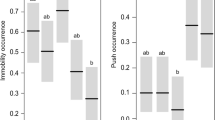Abstract
Males of Brechmorhoga pertinax(Hagen) patrolled and competed for narrow strips of stream edge, 2–8 m long, containing a few barely submerged patches of sandy or fine gravel substrate. These scarce patches were used as oviposition sites by females that usually, but not always, mated with a patrolling male just prior to egg-laying. Females visited the oviposition sites evenly throughout the day from 0830 to 1430 but male activity rose until midday and then declined sharply after 1330. Some gravid females refused to mate in the midafternoon despite male efforts to copulate with them. The average patrolling bout by a male lasted less than 15 min, with defenders usually leaving immediately after one or two aggressive interactions with intruders or leaving voluntarily without apparent cause. Many individuals returned for additional bouts of patrolling at the same site, but the total daily period of patrolling for any one individual almost never exceeded 1 h.
Similar content being viewed by others
References
Alcock, J. (1985). Reproductive behavior ofCordulegaster diadema Selys (Anisoptera: Cordulegastridae).Odonatologica 14: 313–317.
Alcock, J. (1988). Male reproductive tactics in the libellulid dragonflyPaltothemis lineatipes: Temporal partitioning of territories.Behaviour 103: 157–173.
Campanella, P. J. (1975). The evolution of mating systems in temperate zone dragonfiies (Odonata: Anisoptera). II.Libellula luctuosa (Burmeister).Behaviour 54: 278–310.
Campanella, P. J., and Wolf, L. L. (1974). Temporal leks as a mating system in a temperate zone dragonfly (Odonata: Anisoptera). I.Plathemis lydia (Drry).Behaviour 51: 49–87.
Clement, S. L., and Meyer, R. P. (1980). Adult biology and behavior of the dragonflyTanypteryx hageni (Odonata: Petaluridae).J. Kans. Entomol. Soc. 53: 711–719.
Corbet, P. S. (1962).A Biology of Dragonflies, Witherby, London.
Fried, C. S., and May, M. L. (1983). Energy expenditure and food intake of territorial malePachydiplax longipennis (Odonata: Libellulidae).Ecol. Entomol. 8: 283–292.
Hassan, A. T. (1978). Reproductive behaviour ofAcisoma panorpoides inflatum Selys (Anisoptera: Libellulidae).Odonatologica 7: 237–245.
Heinrich, B., and Casey, T. M. (1978). Heat transfer in dragonflies: “fliers” and “perchers.”J. Exp. Biol. 74: 17–36.
Higashi, K. (1969). Territoriality and dispersal in the population of dragonfly,Crocothemis servilia Drury (Odonata: Anisoptera).Mem. Fac. Sci. Kyushu Univ. Sci. E 5: 95–113.
Hilder, B. E., and Colgan, P. W. (1985). Territorial behaviour of maleNannothemis bella (Uhler) (Anisoptera: Libellulidae).Can. J. Zool. 63: 1010–1016.
Hilton, D. F. J. (1983a). Territoriality inLibellula julia Uhler (Anisoptera: Libellulidae).Odonatologica 12: 115–124.
Hilton, D. F. J. (1983b). Reproductive behavior ofCordulia shurtleffi Scudder (Anisoptera: Corduliidae).Odonatologica 12: 15–23.
Jacobs, M. E. (1955). Studies on territorialism and sexual selection in dragonflies.Ecology 36: 566–585.
Kaiser, H. (1985). Availability of receptive females at the mating place and mating chances of males in the dragonflyAeschna cyanea.Behav. Ecol. Sociobiol. 18: 1–8.
Koenig, W. D., and Albano, S. S. (1985). Patterns of territoriality and mating success in the whitetailed skimmerPlathemis lydia (Odonata: Anisoptera).Am. Midl. Nat. 114: 1–12.
May, M. L. (1977). Thermoregulation and reproductive activity in tropical dragonflies of the genusMicrathyria.Ecology 58: 787–798.
May, M. L. (1980). Temporal activity patterns ofMicrathyria in Central American (Anisoptera: Libellulidae).Odonatologica 9: 57–74.
McVey, M. E., and Smittle, B. J. (1984). Sperm precedence in the dragonflyErythemis simplicollis.J. Insect Physiol. 30: 619–628.
Miller, P. L. (1982). Temporal partitioning and other aspects of reproductive behaviour in two African libellulid dragonflies.Entomol. Month. Mag. 118: 177–187.
Nakamuta, K., Tsubaki, Y., Yasuda, M., and Ono, T. (1983). Male reproductive behavior of the tiny dragonfly,Nannophya pygmaea Rambur.Kontyu 51: 605–613.
Parr, M. J. (1980). Territorial behaviour of the African libellulidOrthetrum julia Kirby (Anisoptera).Odonatologica 9: 75–99.
Parr, M. J. (1983). An analysis of territoriality in libellulid dragonflies (Anisoptera: Libellulidae).Odonatologica 12: 39–57.
Pezalla, V. M. (1979). Behavioral ecology of the dragonflyLibellula pulchella Drury (Odonata: Anisoptera).Am. Midl. Nat. 102: 1–22.
Poethke, H.-J., and Kaiser, H. (1985). A simulation approach to evolutionary game theory: The evolution of time-sharing behavior in a dragonfly mating system.Behav. Ecol. Sociobiol. 18: 155–163.
Sakagami, S. F., Ubukata, H., Iga, M., and Toda, M. J. (1974). Observations on the behavior of some Odonata in the Bonin Islands, with considerations on the evolution of reproductive behavior in Libellulidae.J. Fac. Sci. Hokkaido Univ. 19: 722–757.
Sherman, K. J. (1983). The adaptive significance of postcopulatory mate guarding in a dragonfly,Pachydiplax longipennis.Anim. Behav. 31: 1107–1115.
Ubukata, H. (1975). Life history and behavior of a corduliid dragonfly,Cordulia aenea amurensis Selys. II. Reproductive period with special reference to territoriality.J. Fac. Sci. Hokkaido Univ. Ser. VI Zool. 19: 812–833.
Ubukata, H. (1979). Behaviour ofSomatochlora viridiaenea viridiaenea Uhler in Kushiro district (Odonata, Corduliidae).New Entomol. 28: 1–7.
Ubukata, H. (1984). Oviposition site selection and avoidance of additional mating by females of the dragonfly,Cordulia aenea amurensis Selys (Corduliidae).Res. Pop. Ecol. 26: 285–301.
Uéda, T. (1979). Plasticity of the reproductive behaviour in a dragonfly,Sympetrum parvulum Barteneff, with reference to the social relationship of males and the density of territories.Res. Pop. Ecol. 21: 135–152.
Waage, J. K. (1984). Sperm competition and the evolution of odonate mating systems. In Smith, R. L. (ed.),Sperm Competition and the Evolution of Animal Mating Systems, Academic Press, New York, pp. 251–290.
Wolf, L. L., and Waltz, E. C. (1984). Dominions and site-fixed aggressive behavior in breeding maleLeucorrhinia intacta (Odonata: Libellulidae).Behav. Ecol. Sociobiol. 14: 107–115.
Author information
Authors and Affiliations
Rights and permissions
About this article
Cite this article
Alcock, J. The mating system ofBrechmorhoga pertinax (Hagen): The evolution of brief patrolling bouts in a “territorial” dragonfly (Odonata: Libellulidae). J Insect Behav 2, 49–62 (1989). https://doi.org/10.1007/BF01053618
Accepted:
Issue Date:
DOI: https://doi.org/10.1007/BF01053618




